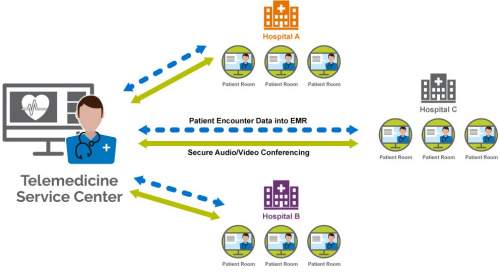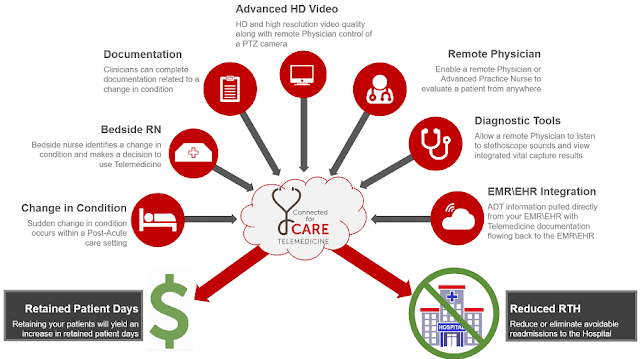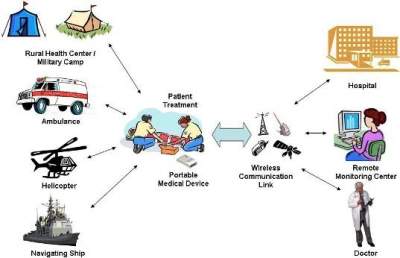The US Telemedicne Policy Latest
US telemedicine industry has undergone a sea change through the history and evolution of the Texas Telemedicine Act and
the implications of the passage of the Act for Texas, the telehealth industry,
and the United States as a whole. Thus you will clearly understand the latest US telemedicine policy.
Texas Governor
Greg Abbott on Tele medicine
On May 27, 2017,
Governor of Texas (hereinafter referred to as Texas) Greg Abbott passed the
state's telemedicine legislation bill (the Senate Bill SB1107 and House Bill
HB2697), abolishing doctors only in face-to-face contact with patients After
that, it is possible to provide telehealth services.
As the last of
the 50 states in the United States to repeal this rule, the Texas Telemedicine
Act allowed a number of telemedicine companies, such as Teladoc, American Well,
Doctor on Demand, and MD Live, to extend their remote video business to
National market.
 |
| Telemedicine Laws |
But in a strict
sense, telemedicine operations in Arkansas and Idaho still have limitations
because the two states still have restrictions on telemedicine telephony
services.
Texas is the
second largest state in the United States and the largest state in the southern
United States. The passage of the bill is not only about opening up a new
market for telemedicine, but more importantly, enabling the people of Texas to
enjoy more diverse medical services. In addition, the bill marks the end of a
two-year lawsuit between Teladoc and the Texas Medical Board, making it a
landmark antitrust case in the US medical industry.
At this historic
moment, the Internet medical information website MobiHealthNews sorted out the
history of the Texas Telemedicine Act. This article takes you through the
history and evolution of the bill and the implications of the passage of the
bill for Texas, the telemedicine industry, and the United States as a whole.
Teladoc and
Medical Board lawsuits, litigation costs up to $7 million a quarter
Texas has a
large number of rural poor, and telehealth can bring scarce medical services to
these people. From this perspective, it should not be the last state to approve
telemedicine business.
Jason Gorevic,
CEO of Teladoc, said: “There are 35 families in Texas who do not have any
family doctors. The state has the highest population growth rate in the United
States, but its number of primary care physicians per capita is only the fifth
lowest. Access to services is a big problem in Texas."
Dallas-based
Teladoc has been operating in Texas since 2005. However, in 2010, the Texas
Medical Board passed a revision of the prescription rules for telemedicine, requiring
doctors to conduct face-to-face consultations with patients before providing
telemedicine services.
Medical
committees vs Telemedicine companies
Medical
committees and telemedicine companies have different interpretations of this
revision. Companies such as Teladoc and MDLive believe that this regulation is
only for video-based businesses, and it only limits video services and
continues to provide telephony services in Texas. However, the Medical Council
believes that these companies have exploited linguistic vulnerabilities and
that their intentions are clear: to ban all telemedicine services that are not
face-to-face.
Therefore, when
Teladoc continued to provide telemedicine services to the Texas public by
telephone, the Texas Medical Board sent an open letter to them asking them to
stop providing any services immediately. A contingency rule was issued that
clarified any ambiguity between the telephone and video services in the
previous version. Teladoc then countered that the rule was not followed by
proper procedures and prosecuted.
Lawsuit in 2015
The lawsuit has
intensified in April 2015 and may have been directly reported to the Supreme
Court. Teladoc sued the Medical Board under the Anti-Monopoly Law, calling it a
licensed physician organization that would limit the development of
telemedicine to bring economic benefits, and the Medical Board could not pass
such a regulation aimed at curbing other competitors.
The lawsuit took
two years and Teledoc paid a huge economic price for it. According to the
company's 2016 public financial report, spending on litigation is as high as $7
million in just one quarter. But Teledoc CEO Gorevic believes that all this is
worthwhile because they are fighting for their right to run their business and
the right of customers to get better medical services. On the other hand, they
dare to stand up and challenge the authority, and the side also shows their
leadership in the telemedicine industry.
From the
perspective of the lawsuit, everything seems to be more favorable to Teledoc.
The US Federal Trade Commission (FTC), an important antitrust agency of the US
government, even submitted to the court a "Friends of the Court"
complaint that favored Teledoc's position. But in the end, both sides realized
that the long-lost lawsuit would only hurt both sides. Instead of appealing to
a higher court, it would be better to sit down and negotiate. Last fall, the
two sides demanded that the case be suspended and began to show signs of
reconciliation.
Gorevic
concluded that the signing of the bill would completely end the lawsuit because
it was "no need for litigation."
 |
| Telemedicine Practice |
Good Telemedicine policy can
solve problems in the medical system and promote the legislative process
Since 2015,
Teledoc has been in court with the Texas Medical Board. For two years, people
have been trying to use legislation to end the lawsuit and reach a compromise.
According to
LaToya Thomas, director of the National Center for Policy Resources at the
American Association of Telemedicine (ATA), legal guidance is not only the only
way to resolve the conflict between Teledoc and the Texas Medical Board, but
also a necessary way to prevent similar conflicts in the future.
Thomas believes
that the case in Texas is very special because it involves not only the medical
committee but also other committees. The state’s advisory committee had wanted
to pass similar rules, but fortunately it was blocked. Therefore, it is
necessary to have the participation of state legislators.
Bills on Teledoc case
Nora Belcher,
director of the Texas Electronic Medical Alliance, said that the early
legislative attempts were too confusing to be passed in the legislature.
Therefore, although a series of bills have been proposed to solve the Teledoc
case, it is difficult to really play a role because they are all different from
different angles.
In this case,
Belcher, Teladoc, the Medical Council, and a number of other stakeholders,
including hospitals and care practitioners, began to sit down and discuss
together. They tried to meet a full year before the start of the Legislative Council
and drafted a bill that would satisfy everyone.
It turns out
that there are not too many requirements for suppliers (referring to medical
service providers): they want to ensure a sound standard of care, do not change
the licensing arrangements, clarify matters related to reimbursement,
especially the medical insurance plan will not be a phone call. Ask a doctor or
fax a bill. But the legislature does not want to pass a “supplier bill” but
will protect all telemedicine providers. The bill passed this time solves all
these problems.
Gorevic believes
that the root cause of the partnership between Texas and remote companies is
the shift in perceptions of telehealth from 2010 to the present.
Government Regulator on Telemedicine Policy
“Government’s
regulators tend to protect the status quo in change,” he said. “Texas is the
case. If new things show their value and take steps to ensure equality, the
more they can break the status quo and start adapting to innovation. As a
leader in the telemedicine market, Teledoc is able to drive this process. Over
time, people are beginning to understand that telemedicine is not a new gadget,
but a real solution in the medical system. Problems and industries that can
bring great value to the people of Texas."
In the end, the
bill was unanimously passed in both the parliament and the Senate. The bill
passed this time even includes some novel forward-looking regulations, such as
redefining storage and forwarding technologies, including cloud infrastructure.
However, the bill also makes Texas a 20th state that prohibits the use of
telemedicine for abortion, showing that there are still many challenges in the
future development of telemedicine.
3 Acts of Texas
Telemedicine on Telehealth reveal US TelemedicinePolicy
At the 185th
Legislative Council in Texas, SB1107 was the most important bill on
telemedicine. In addition, the following three telemedicine bills were passed
in the Legislative Council.
The SB1633 will
allow more remote pharmacy technology to be used in areas where there are no
pharmacies in Texas. Another bill, HB1697, will provide a donation program for
remote neonatal intensive care unit (NICU) services for premature babies. Then
there is the SB922, which will ensure that the school's telehealth services are
reimbursed for Medicaid.
In addition to
SB1633, two other bills have been submitted to the governor. The remote
pharmacy bill is currently being settled with the House of Representatives and
the Senate.
In this regard,
Belcher said: "This year is a surprising year for us. Last year we
submitted 17 bills, only 2 of which were passed. If three of the four bills
passed this year, not only It will be a structural victory and very
symbolic."
 |
| Conduction of Telemedicine |
Telehealth expands its
business in Texas, and four telemedicine companies in the US are optimistic
Although the current
regulatory status is still not friendly, the four top telehealth companies in
the United States have already established some businesses in Texas. Teladoc
and MDLive have been operating telephone services based on their understanding
of existing regulations. American Well has partnered with Texas hospitals to
use the company's telemedicine services during hospital visits without any
legal problems; mental illness It has not been within the prescribed limits, so
Doctor on Demand has been providing telephone mental health services throughout
the state.
However, with the passage of
the bill, all four companies will be able to implement remote video services in
Texas and across the country.
According to Belcher,
Texas is the last state to allow telemedicine companies to conduct video
services in the state. This is very important for these companies because it
means they can finally strategically deploy in all states across the United
States.
American Well's
attitude was the most cautious before the bill passed. Although the company is
providing telephony services in Texas as described above, company CEO Roy
Schoenberg still emphasizes that unless the medical committee explicitly
supports other business methods for telemedicine, they will not expand their
business in Texas. He said with no irony: "We don't think that operators
who are trying to slap words are thinking that doing this or letting doctors do
this will not be sued."
However, after the
passage of the bill, American Well believes that this will not only benefit the
company's direct sales business, but also help strengthen corporate
partnerships. Schoenberg said that due to the medical committee's regulations,
American Well did not directly operate in Texas, and many of the large national
insurance companies that cooperated with it, such as Anthem and United, were
also affected and could not enter the Texas market.
The New Law on Tele-medicine
The new law just passed
opened the way for American Well and its customers to use its platform to
provide a variety of services in Texas. Previously, these customers were only
able to follow up patients, and now they can finally open the system and take
advantage of all their functions.
Hill Ferguson, CEO of
Doctor on Demand, emailed MobiHealthNews that in Texas, they have been
providing mental health services through the video platform for a long time and
have been successful in this regard. With the passage of the new bill, his
company will gradually expand to other areas of care based on mental health
business.
And MDLive's CEO, Scott
Decker, is not worried about the passage of the bill, which will make the
competition more intense. He believes that MDLive has established a stable
patient population in the Texas telephone service market, and these patients
will not easily switch to other video services. The passage of the bill allows
it to have a wider display in Texas, and the solid user base is the company's
largest net income guarantee.
The biggest obstacle to
the development of telehealth will be reimbursement
The passage of the
Texas Telemedicine Bill was a huge victory, but it was far from the end of the
legislative road. ATA's Latoya Thomas pointed out that some states'
telemedicine situation is not optimistic, such as Connecticut and Rhode Island
still have telehealth restrictive bills for ophthalmology; Arkansas still has a
telephone ban; Iowa Physical Therapy Committee A new regulation is in place
that only licensed physiotherapists can provide telehealth services for
physical therapy.
Thomas also said that
Texas's legislative victory is a good first step and a good example for other
states. If Texas can do this, other states are likely to follow suit. “I think
other states should learn from the Texas experience and give a green light to
local telemedicine.”
Teladoc CEO Gorevic
believes that all parties are very concerned about the telemedicine legislation
in Texas. The support of the Texas legislature is an important recognition of
the value of telehealth. In addition, it complements the positive actions of
Washington.
For example, the 21st
Century Therapy Act signed by Obama in December 2016, the High-Quality Results
and Outcomes Necessary to Improve Chronic, which was just passed in the Senate
Finance Committee in May 2017. High quality outcomes and prognosis, etc.,
support the use of telemedicine to improve the health care system.
Obstacle in Development of Tele-medicine
On the other hand, most
people agree that the biggest obstacle to the development of telemedicine will
be reimbursement. As MDLive's CEO Decker said, the next legislative focus will
be on medical insurance reimbursement for telehealth outpatient clinics across
the US. At present, even in a state like Texas that achieves telemedicine
equality, its reimbursement is actually very difficult.
Schoenberg, CEO of
American Well, believes that “equality” looks good in the legal provisions, but
if doctors ask questions about providing telehealth services to patients and
receiving money, the answer is an embarrassing uncertainty. According to
Schoenberg, the root cause of the problem is the attitude of the federal health
insurance. Maybe it will change in the future, but so far, people can only wait
and see, not sure how to do it.
Conclusion
Of course, Texas's
telemedicine legislation is a great victory. Both parties involved and
legislators can celebrate this rare legislative win-win situation. Especially
for Texas, the second largest state in the United States, it can win more space
for telehealth development here, and it is a great encouragement to all
companies in the industry.
Tags: #USA,
#United States Telemedicine, #American Telemedicine, American
Telemedicine Policy, #Telemedicine in America, #Telemedicine Laws,
#Telemedicine State laws, #Telemedicine Legal
[[SHARE This Article >>>>












